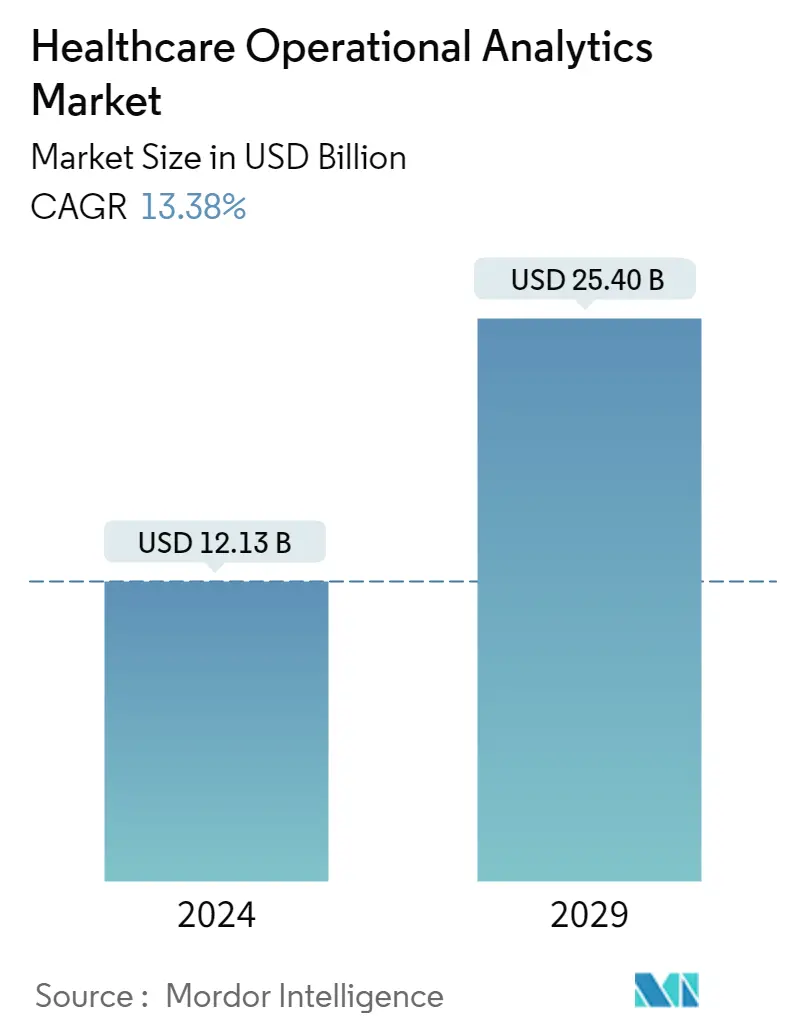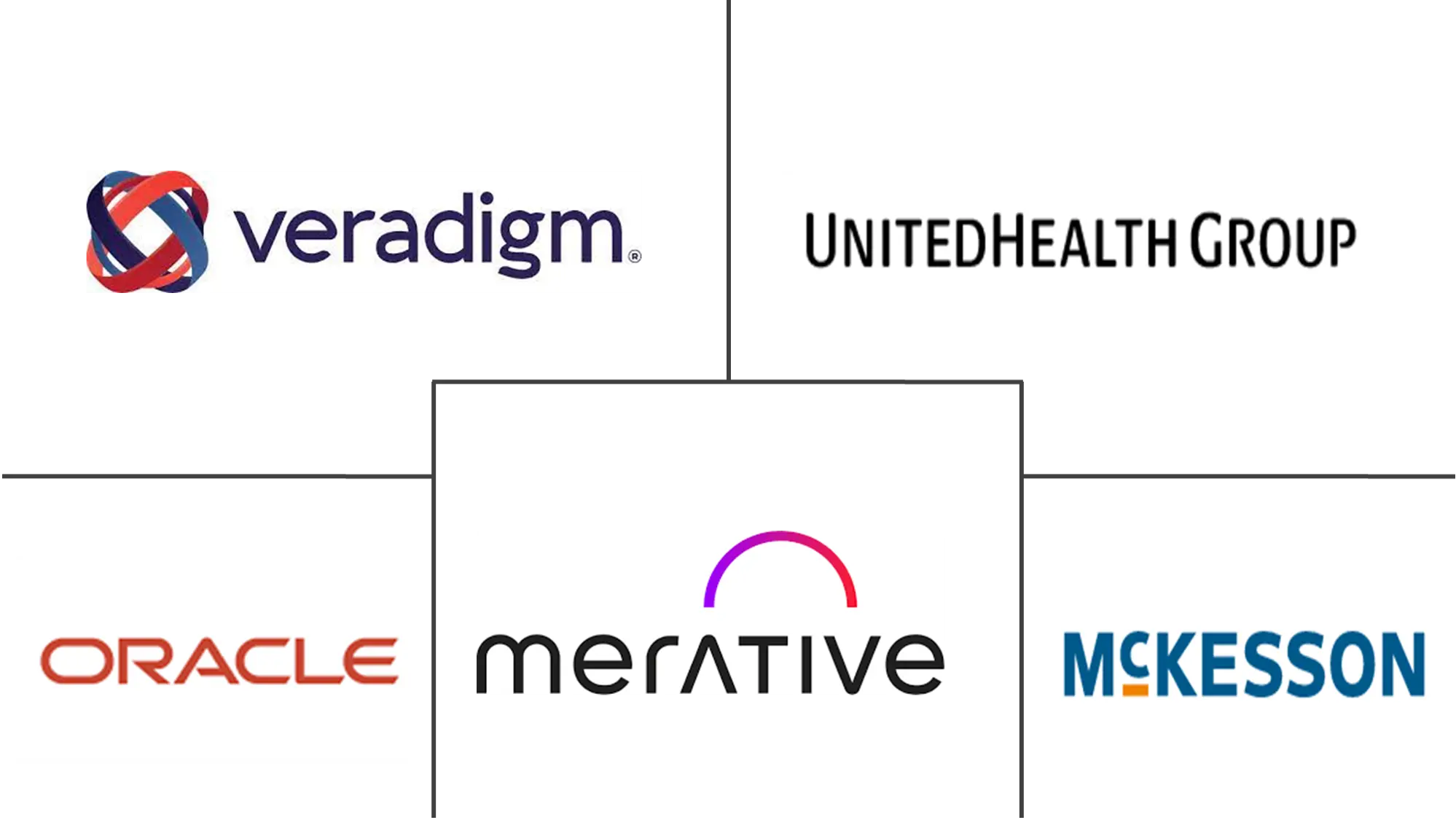Market Size of Healthcare Operational Analytics Industry

| Study Period | 2018 - 2029 |
| Market Size (2024) | USD 12.13 Billion |
| Market Size (2029) | USD 25.40 Billion |
| CAGR (2024 - 2029) | 13.38 % |
| Fastest Growing Market | Asia-Pacific |
| Largest Market | North America |
| Market Concentration | Medium |
Major Players
*Disclaimer: Major Players sorted in no particular order |
Healthcare Operational Analytics Market Analysis
The Healthcare Operational Analytics Market size is estimated at USD 12.13 billion in 2024, and is expected to reach USD 25.40 billion by 2029, growing at a CAGR of 13.38% during the forecast period (2024-2029).
- The COVID-19 pandemic had a significant impact on healthcare operational analytics, transforming the way healthcare organizations utilize data and analytics to manage their operations. One of the most immediate effects was the heightened demand for real-time data to track the spread of the virus, predict resource needs, and allocate resources efficiently. For instance, a book released by the Head of Cybersecurity of the UAE Government in May 2023 revealed that artificial intelligence and big data played a crucial role in tracking and predicting the spread of COVID-19, identification of vulnerable populations, and analysis of high-risk areas for efficient containment and mitigation measures. Therefore, the COVID-19 pandemic accelerated the adoption of data-driven decision-making in healthcare operations, highlighting the need for real-time data analytics, supply chain optimization, and the integration of telehealth data. These changes have not only improved crisis response capabilities but have also set the stage for a more data-driven and resilient healthcare system in the post-pandemic era.
- The major factors driving the market growth include increasing demand for value-based care (VBC), rising need to analyze the collected healthcare data, and rising awareness regarding healthcare standards and improving technologies. The demand for value-based care in healthcare is increasing for several reasons, driven by a desire to improve the overall quality and efficiency of healthcare delivery while managing costs. Some of the key factors contributing to the growing demand for value-based care include a focus on patient outcomes, cost containment, chronic disease management, advancement in health technology, and others. For instance, according to the report published by the National Health Authority of India in 2022, the government of India is shifting its focus from volume-based to value-based healthcare under its Pradhan Mantri Jan Arogya Yojana (PM-JAY) program by establishing PM-JAY Quality Certification Program which provides bronze, silver, and gold certification for the enlisted healthcare providers (EHCPs). Also, as per the same source, this 3-tier certification program has been launched to help hospitals improve their quality and patient safety, and the enlisted hospitals qualifying for the certification receive financial incentives linked to different levels of accreditation/certifications. This instills the importance and necessity of VBC, thereby increasing their adoption by more healthcare providers.
- In addition, the surging support from government bodies is also projected to drive market growth during the forecast period. For instance, in January 2023, the National Health Authority (NHA) of India launched the Digital Health Incentive Scheme (DHIS) to boost digital health transactions in India under the Ayushman Bharat Digital Mission (ABDM). Under the DHIS, the government has allocated INR 4 crore (USD 500,000) for clinics, diagnostic centers, hospitals, and laboratories based on the number of digital health records created and linked to the Ayushman Bharat Health Account. Such initiatives are expected to boost the adoption of healthcare analytics solutions as they can help streamline and enhance the healthcare system of countries.
- Moreover, with the rising demand for value-based care and healthcare data analysis, as well as the generation of huge amounts of healthcare data with digitalization, the companies in the studied market are continuously engaged in research and development activities to enhance the capabilities of their offerings and launching new products/solutions in the market which is further expected to boost the market's growth. For instance, in June 2023, Syntax Health launched a platform that removes friction in the contracting process using analytics, infrastructure, and a collaborative Virtual Workspace. As per the company, its new two-sided software-as-a-service solution allows payers and providers (as well as actuaries, network managers, and analysts) to collaborate in creating a value-based contract.
- Therefore, due to the increasing demand for value-based care, the rising need to analyze the collected healthcare data, and rising awareness regarding healthcare standards and improving technologies, the market studied is expected to witness significant growth. However, concerns regarding data privacy and security and the lack of trained IT professionals in healthcare may hinder the market's growth.
Healthcare Operational Analytics Industry Segmentation
As per the scope of the report, analytics helps an organization through the systematic use of technologies, methods, and data to derive insights and to enable fact-based decision-making for planning, management, operational activities, measurement, and learning. With the availability of large data sets in the healthcare industry, it has become necessary for companies to be equipped with operational analytics tools to use data efficiently.
The healthcare operational analytics market is segmented by type (supply chain analytics, human resource analytics, and strategic analytics), component (software, hardware, and services), deployment (on-premise, web and cloud-based), end user (hospitals and clinics, pharmaceutical and biotechnology companies, and other end users) and geography (North America, Europe, Asia-Pacific, Middle East, and Africa, and South America). The report also covers the estimated market sizes and trends for 17 countries across major regions globally.
The report offers the value (in USD) for the above segments.
| By Type | |
| Supply Chain Analytics | |
| Human Resource Analytics | |
| Strategic Analytics |
| By Component | |
| Software | |
| Hardware | |
| Services |
| By Deployment | |
| On-Premise |
| By En User | |
| Hospitals and Clinics | |
| Pharmaceutical and Biotechnology Companies | |
| Other End Users |
| By Geography | ||||||||
| ||||||||
| ||||||||
| ||||||||
| ||||||||
|
Healthcare Operational Analytics Market Size Summary
The healthcare operational analytics market is poised for substantial growth, driven by the increasing demand for value-based care and the need to analyze vast amounts of healthcare data. The COVID-19 pandemic has significantly accelerated the adoption of data-driven decision-making, emphasizing the importance of real-time data analytics and supply chain optimization. This shift has been further supported by advancements in technologies such as artificial intelligence and machine learning, which are being integrated into healthcare operational analytics software to enhance efficiency and improve patient outcomes. The market is also witnessing a surge in government initiatives aimed at boosting digital health transactions and improving healthcare standards, which are expected to further propel market growth.
North America is anticipated to experience significant expansion in the healthcare operational analytics market, fueled by the region's advanced healthcare infrastructure and the increasing number of healthcare organizations. The adoption of paperless technologies, such as electronic health records, is also contributing to market growth. The competitive landscape is moderately consolidated, with key players like Oracle Corporation, MERATIVE, and McKesson Corporation leading the market. Strategic initiatives, including product launches and partnerships, are enhancing the market's growth prospects, particularly in regions like the United States and Mexico. These developments underscore the market's potential for continued expansion over the forecast period.
Healthcare Operational Analytics Market Size - Table of Contents
-
1. MARKET DYNAMICS
-
1.1 Market Overview
-
1.2 Market Drivers
-
1.2.1 Increasing Demand for Value-Based Care (VBC)
-
1.2.2 Rising Need to Analyze the Collected Healthcare Data
-
1.2.3 Rising Awareness regarding Healthcare Standards and Improving Technologies
-
-
1.3 Market Restraints
-
1.3.1 Concerns regarding Data Privacy and Security
-
1.3.2 Lack of Trained IT Professionals in Healthcare
-
-
1.4 Porter's Five Forces Analysis
-
1.4.1 Threat of New Entrants
-
1.4.2 Bargaining Power of Buyers/Consumers
-
1.4.3 Bargaining Power of Suppliers
-
1.4.4 Threat of Substitute Products
-
1.4.5 Intensity of Competitive Rivalry
-
-
-
2. MARKET SEGMENTATION (Market Size by Value - USD)
-
2.1 By Type
-
2.1.1 Supply Chain Analytics
-
2.1.2 Human Resource Analytics
-
2.1.3 Strategic Analytics
-
-
2.2 By Component
-
2.2.1 Software
-
2.2.2 Hardware
-
2.2.3 Services
-
-
2.3 By Deployment
-
2.3.1 On-Premise
-
-
2.4 By En User
-
2.4.1 Hospitals and Clinics
-
2.4.2 Pharmaceutical and Biotechnology Companies
-
2.4.3 Other End Users
-
-
2.5 By Geography
-
2.5.1 North America
-
2.5.1.1 United States
-
2.5.1.2 Canada
-
2.5.1.3 Mexico
-
-
2.5.2 Europe
-
2.5.2.1 Germany
-
2.5.2.2 United Kingdom
-
2.5.2.3 France
-
2.5.2.4 Italy
-
2.5.2.5 Spain
-
2.5.2.6 Rest of Europe
-
-
2.5.3 Asia-Pacific
-
2.5.3.1 China
-
2.5.3.2 Japan
-
2.5.3.3 India
-
2.5.3.4 Australia
-
2.5.3.5 South Korea
-
2.5.3.6 Rest of Asia-Pacific
-
-
2.5.4 Middle East and Africa
-
2.5.4.1 GCC
-
2.5.4.2 South Africa
-
2.5.4.3 Rest of Middle East and Africa
-
-
2.5.5 South America
-
2.5.5.1 Brazil
-
2.5.5.2 Argentina
-
2.5.5.3 Rest of South America
-
-
-
Healthcare Operational Analytics Market Size FAQs
How big is the Healthcare Operational Analytics Market?
The Healthcare Operational Analytics Market size is expected to reach USD 12.13 billion in 2024 and grow at a CAGR of 13.38% to reach USD 25.40 billion by 2029.
What is the current Healthcare Operational Analytics Market size?
In 2024, the Healthcare Operational Analytics Market size is expected to reach USD 12.13 billion.

